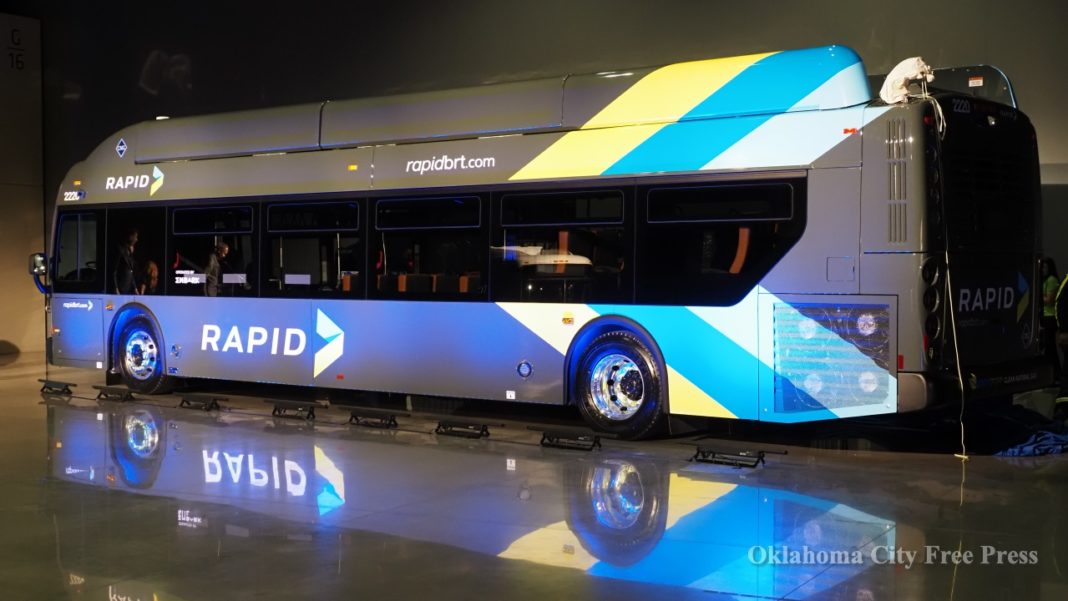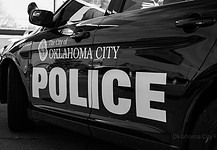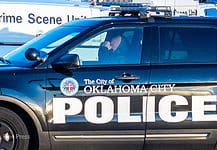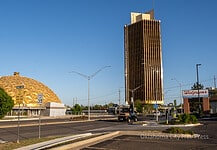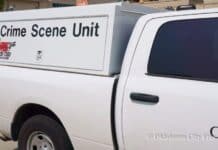Last Updated on May 30, 2022, 4:26 PM | Published: May 26, 2022
OKLAHOMA CITY (Free Press) — Slated to be operational by Fall 2023, the first bus rapid transit (BRT) line in Oklahoma City moved one step closer to completion with a reveal of the new equipment that will be used on the line Thursday.
“This is the closest we will ever get to a subway in Oklahoma City,” said Mayor David Holt before the drape was removed revealing a new, distinctive paint scheme on the first of nine new compressed natural gas (CNG) busses equipped just for the line.
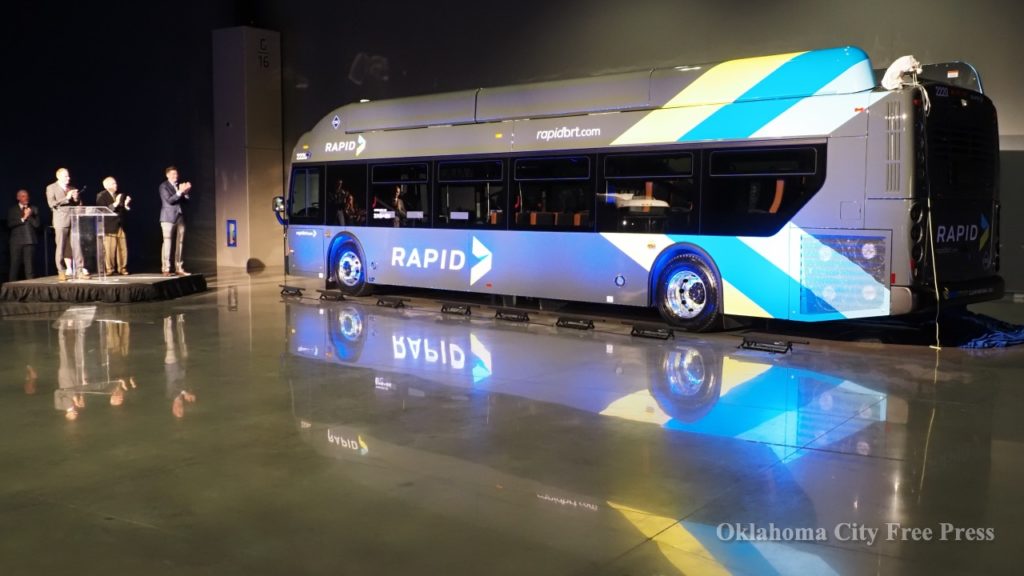
He pointed out that with the special lanes to speed busses between downtown and the end of the line at N. Meridian and the Northwest Expressway and with sheltered platforms similar to the current streetcar platforms, users will have better seats and wifi accommodations plus USB charging ports for electronic devices.
According to information from EMBARK staff, the first line will begin construction in summer 2022. The RAPID NE line will start the planning phase in 2025 and the South line in 2026.
The northwest line is only the first to be planned. A second BRT line going northeast and another to go south are in the works to come into service after the northwest line is established.
According to EMBARK, “The overall goal of the RAPID system is to expand local and regional mobility options, improve job access, support transit-oriented development (TOD), help improve community health and enhance livability along the corridor.”
Here is the route for the Northwest RapidBRT line:
RAPID_Route_2022_V4Key elements
Based on the criteria set by the Federal Transit Administration for BRT lines here are the key features of the new BRT lines:
- Running Way
- EMBARK’s RAPID will run as an existing mixed flow lane service.
- Stations
- With 32 enhanced stops that include level boarding for universal access and alighting as well as real-time arrival information, EMBARK’s RAPID will differentiate itself from its in-place fixed-route bus system stops.
- Vehicles
- RAPID vehicles are 40-feet long and are powered by clean natural gas. The seats are upgraded for enhanced comfort and Wi-Fi will be available throughout the bus.
- Off-Board Fare Collection
- Fare collection for EMBARK’s RAPID will be electronic via mobile app, Token Transit, or manual via kiosks on located on each platform.
- Intelligent Transportation Systems
- RAPID lines will implement priority signaling and real-time tracking in tandem that will prioritize RAPID vehicles creating a fast and reliable customer experience.
- Service and Operations Plans
- EMBARK’s first RAPID line have vehicles arriving at stops approximately every 15 minutes along the 9 1/2-mile corridor.
Expecting more use of public transit
After the big reveal Free Press asked EMBARK and Central Oklahoma Transportation and Parking Authority (COTPA) Director Jason Ferbrache what some challenges would be in getting the public to ride the new Northwest BRT since it’s not something that has been there or a part of their routine before.

“Well, it’s that reoccurring challenge we have and that is getting people comfortable in our community with the idea of using public transit,” said Ferbrache.
“But you know, … this is a bus rapid transit line. So it’s essentially a line on the map. It’s very intuitive, easy to follow. [During peak times it will have] 12-minute frequency. You basically do not need a map or a schedule to use this system. So, I think that’s going to be a real help in terms of of knocking down any barrier that folks might have wanting to try it.”
He said that even in off-peak times, the line is designed to have busses coming to each stop every 18 to 20 minutes which means that anyone can simply come to a stop and know that soon they will get a bus.
Ferbrache also said that the new, sheltered and raised platform stops would have digital signage connected to the system notifying those who are waiting of how long it will be until the next bus arrives which will eliminate even more guesswork and resulting reluctance to ride the line.
Jeff Bezdek, long a proponent of expanding public transit in the OKC metro and region talked to Free Press about the plusses of the Rapid system expansion.
“What’s really exciting is it’s a lower cost way for us to reach areas that need a lot of movement and needed to be able to move people quickly,” said Bezdek. “And, in MAPS 4, we have a significant amount of money to essentially take this and expand it to the northeast and to the south, and really develop a good cross pollination between transit vehicles.”

Council members’ comments
Ward 6 City Councilor JoBeth Hamon was present and told us that she thought the new BRT line has some advantages and visibility that just another bus route would not have. Much of the lower end of the Northwest BRT will be in Hamon’s ward.
“The stops will have a dedicated station platform with all those amenities that are just a lot more visible for people whereas a lot of our fixed route services,” don’t have a platform.
Hamon said that the more frequent service would draw people to the new line as well plus the new equipment with the distinctive appearance of the dedicated busses.
Almost all the northern part of the new BRT will be in Ward 2 represented by Councilor James Cooper who was a passionate booster of the OKC Streetcar concept and has been positive about the BRT concept as well.
Cooper told us later that he believes the signal prioritization of the BRT concept will help keep the busses on time and with the frequency the concept calls for.
However, he told us there are some changes not adopted that could make sure the northwest BRT is as reliable as needed to create more ridership.
Cooper focused on the multiple lanes on Classen and the Northwest Expressway.
“We don’t need six lanes on Classen. And we don’t need six lanes on Northwest expressway. [Some of] those could be BRT and carpool-only lanes,” said Cooper. “I am hopeful the signal prioritization is effective enough to create those 12 to 20 minute frequencies. That’s my hope. I’m trusting EMBARK on that.”
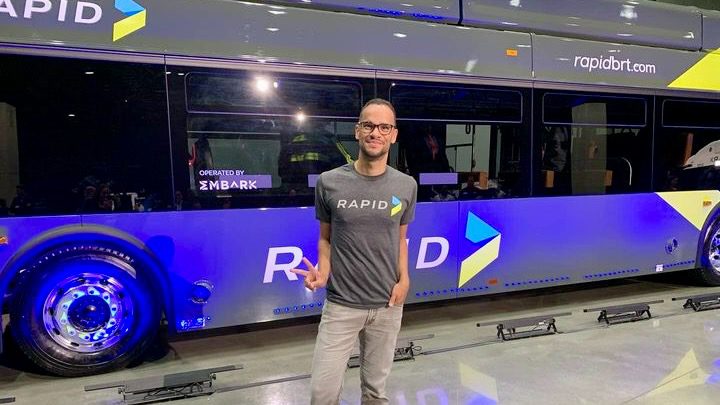
Founder, publisher, and editor of Oklahoma City Free Press. Brett continues to contribute reports and photography to this site as he runs the business.
